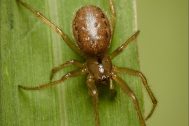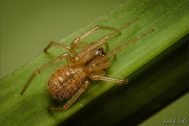During faunistic research of reed beds associated with lakes in the Pannonian region of Czechia we found an Enoplognatha species with spectacular morphology of the male chelicerae. Despite this species being found in an arachnologically well researched area, and that the European species of the genus Enoplognatha have been recently revised (Bosmans & Van Keer 1999), it appears to be a new species.
Bosmans and Van Keer (1999) divided the 29 European and Mediterranean Enoplognatha species into five phenetic groups. Based of the presence of additional teeth on the male basal cheliceral segments, the folium on the dorsal abdomen, and moderately long legs, Enoplognatha bryjai n. sp. (as well as E. monstrabilis Marusik & Logunov, 2001 from Baikal) belongs to the nigromarginata species group. The remaining western Palearctic species of this group are E. mordax (Thorell, 1875), E. mariae Bosmans & Van Keer, 1999, E. nigromarginata (Lucas, 1846), and E. caricis (Fickert, 1876).
The terminology of male palpal structures follows Agnarsson et al. (2007). Descriptive measurements are given in millimeters. We thank Vítězslav Bryja for introducing us to this species and providing us with the material, Tomáš Krejčí and Jan Dolanský for help with collecting additional material and providing photographs, Cor Vink, Miquel Arnedo, Gustavo Hormiga, Marie Luise Schmidt, and an anonymous reviewer for correcting the manuscript. This study was supported by the Ministry of Agriculture of the Czech Republic (grant MZe RO0415) and Sciex-NMSch fellowship 11.231.





